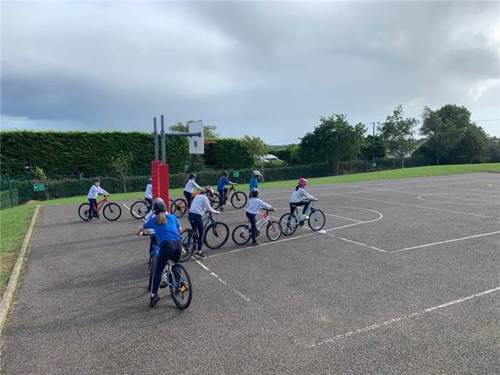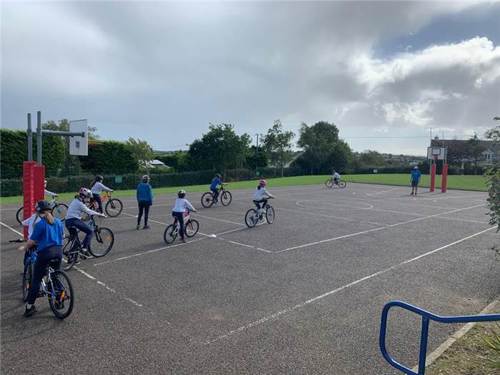Teachers and Schools Documents

CYCLE RIGHT For Teachers Assessing A Childs Cycling Skills
CYCLE RIGHT For Teachers Cycling With Children On Roads

CYCLE RIGHT For Teachers Stage One Session One
CYCLE RIGHT For Teachers Stage One Session Two
CYCLE RIGHT For Teachers Stage One Session Three
CYCLE RIGHT For Teachers Stage One Session Four
CYCLE RIGHT For Teachers Stage One Session Five
CYCLE RIGHT For Teachers Stage One Session Six
CYCLE RIGHT For Teachers Stage One Sessions Seven And Eight

CYCLE RIGHT For Teachers Cycling For The First Time
Code Of Practice And Guidelines For Schools
CYCLE RIGHT Classroom Project For Schools
CYCLE RIGHT Classroom Exercises
An Taisce Green Schools Bike Type Treasure Hunt
An Taisce Green Schools Bike Part Language Treasure Hunt
CYCLE RIGHT Inclusiveness In Training Sessions
Film Resources
Parents and Guardians Documents
CYCLE RIGHT For Parents And Guardians Assessing A Childs Skill Level
CYCLE RIGHT For Parents And Guardians Cycling On Roads
CYCLE RIGHT For Parents And Guardians Puncture Repair
CYCLE RIGHT For Parents And Guardians Tips For Cyclists And Cycling With Children
CYCLE RIGHT For Parents And Guardians Stage One Session One
CYCLE RIGHT For Parents And Guardians Stage One Session Two
CYCLE RIGHT For Parents And Guardians Stage One Session Three
CYCLE RIGHT For Parents And Guardians Stage One Session Four
CYCLE RIGHT For Parents And Guardians Stage One Session Five
CYCLE RIGHT For Parents And Guardians Stage One Session Six
CYCLE RIGHT For Parents And Guardians Stage One Session Seven And Eight
CYCLE RIGHT For Parents And Guardians Teaching A Child To Cycle For The First Time
Code Of Practice And Guidelines For Parents And Guardians
CYCLE RIGHT Going Cycling With A Child
Film Resources
Cycle Right Learn to Cycle and Cycling with a Child on the Road YouTube links
Learning to Cycle - Taking off the Pedals
Learning to Cycle - Getting ready to go
Learning to Cycle - Striding
Learning to Cycle - Gliding
Learning to Cycle - Pedalling
Learning to Cycle - Starting off
Learning to Cycle - Turning
Cycling with a Child on the Road - Left turn from a small road
Cycling with a Child on the Road - Right turn from a small road
Cycling with a Child on the Road - Right turn from a major road
Cycling with a Child on the Road - Walking right turn
Independent Cycling with a Disability Documents
The Benefits Of Cycling For Individuals With A Disability
Different Forms Of Disability And The Learning Process
Inclusiveness In CYCLE RIGHT Sessions
CYCLE RIGHT Learning To Cycle With A Disability
CYCLE RIGHT Learn To Cycle Cert
CYCLE RIGHT Problem Solving Guide For Learn To Cycle Groups
CYCLE RIGHT Learn To Cycle Specialised Equipment
CYCLE RIGHT Guide To For Working With Assistants In Learn To Cycle Sessions
CYCLE RIGHT Goals And Milestones In Learn To Cycle Sessions
Cycle Right Learn To Cycle With A Disability Further Training
Active Disability Ireland Inclusion Continuum Factsheet
Active Disability Ireland TREE Model Factsheet
Active Disability Ireland ADHD Factsheet
Active Disability Ireland Amputee Factsheet
Active Disability Ireland Autism Factsheet
Active Disability Ireland Autism 8 Senses Factsheet
Active Disability Ireland Cerebral Palsy Factsheet
Active Disability Ireland Deafhard Of Hearing Factsheet
Active Disability Ireland Vision Impairment Factsheet
Active Disability Ireland Manual Wheelchair User Factsheet
Active Disability Ireland Intellectual Disability Factsheet
Active Disability Ireland Working With Individuals With Disabilities Factsheet
Active Disability Ireland Physical Activity Pyramid Factsheet
Film Resources
Adults Documents
Tom Ryan Naas CC CYCLE RIGHT Opinion Piece
CYCLE RIGHT Adult Training Support
CYCLE RIGHT Stage 2 For Adults
CYCLE RIGHT Stage 3 For Adults
Cycle Right Guide To Assessing Adults At Stages 2 And 3
Film Resources
*** IN DEVELOPMENT - DUE SOON ***
Cycle Right Online Resources
You can use the Cycle Right E-learning course to increase your knowledge on critical areas such as:
Preparing for the road – clothing, helmet, bike, conditions and wayfinding;
Cycling with others – awareness of other road users, cycling in groups, cycling with children;
Being on the road – positioning, turning, other vehicles;
Knowing the roads – road infrastructure, slip roads, hard shoulders, cycle paths, bus lanes, rail tracks;
Visibility – the importance of being seen on the road.
Moving through a series of independent modules, films and interactive devices will illustrate key points for cyclists using the road network. Find answers to questions such as:
What does a cyclist need to watch out for when approaching a slip road?
What are the different pieces of equipment an adult carrying a child has to choose from?
What is the best way to cross a tramline?
Each module has its own short self-test and the course is digitally certified.
You can use the Cycle Right Parent and Guardian course to increase your knowledge on cycling with children and supporting them to become safe cyclists:
Preparing to go cycling – clothing, helmet, bike and conditions checks;
Teaching a child to cycle – from the first time on a bike through balance and pedalling to independent cycling;
Features of the road environment – situations to be conscious of and how to guide children through them;
Turning left and right – the steps to outline to a child in making these essential manoeuvres on a bike;
Cycling with a child – what position should you, as an adult, take and how can you support a child cycling on the road.
Moving through a series of independent modules, films and interactive devices will illustrate key points for parents and guardians to focus on, when supporting a child to become a confident, competent cyclist
Each module has its own short self-test.
Cycle Right Forms
FORMS Incident And Accident Report Form
Cycle Right Learn To Cycle With A Disability Letter For Parents
Cycle Right Learn To Cycle With A Disability Completion Form